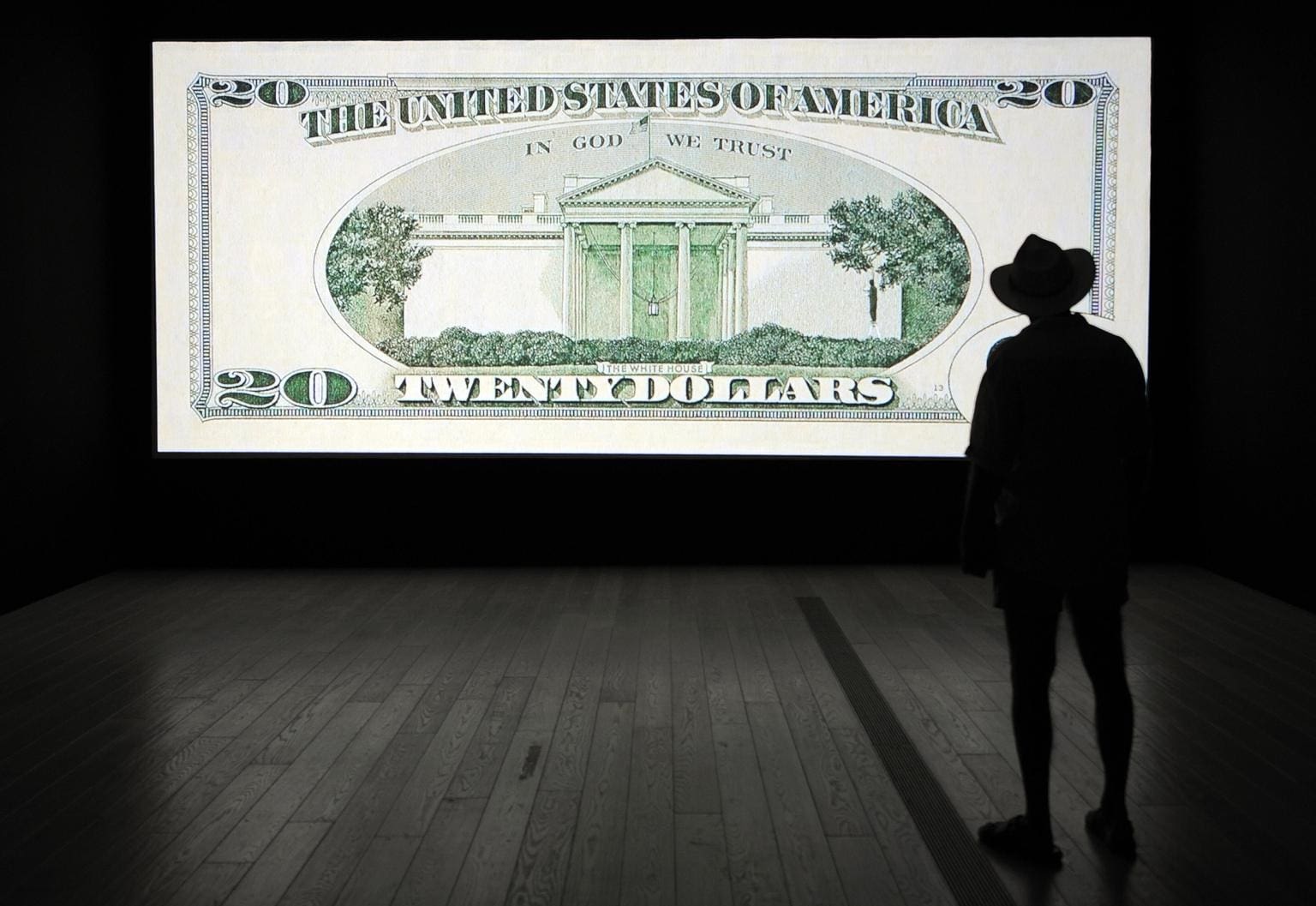Argument: Terminal Deflation Is Coming
Public health efforts to contain the coronavirus pandemic have brought about the most abrupt economic collapse in recorded history, and efforts to contain that collapse have entailed unprecedented experiments in monetary policy. The U.S. Federal Reserve has established nine new lending facilities in its efforts to supply the entire world with dollar liquidity. Buying all manner of private and public debt has expanded the Fed’s balance sheet from $4.1 trillion in late February to over $6.5 trillion by mid-April. Analysts have predicted its balance sheet is on course to reach $9 trillion by the end of the year. Suffice it to say, at its present pace, the Fed is injecting about $1 million into the financial system every second, with a declared upper bound of infinity.
Sailing in uncharted waters invites speculation about what sort of dangers might sink the ship. One common failure scenario for the Fed’s new monetary policies is the fear that $1 million per second for the indefinite future will cause an inflationary disaster. That fear is intuitive, widely held, and influential. It is also completely misplaced. Economic history suggests that deflation, not inflation, is by far the more likely—and in some ways the more dangerous—destination of the Fed’s current trajectory without yet more unprecedented action.
Neither the public nor policymakers are used to worrying about deflation. Instead, memories of stagflation, which most countries in the developed, capitalist West experienced for most of the 1970s—a combination of high rates of inflation, low economic growth, and relatively high unemployment—have shaped the academic training, mental analogies, and policy objectives of central bankers far more than deflation has. Part of the reason is that inflation is bad for creditors, as it erodes the real value of the loans they have made, and, since the banking community is made up of creditors, central bankers are more acculturated to seeing inflation as a threat.
Part of the reason is that stagflation posed a profound intellectual challenge to how central bankers, who believed inflation and unemployment to be opposites, understood their powers and purposes. They thought they could solve unemployment with expansionary monetary policy, but that would increase inflation even higher than it already was. They could solve the existing inflation problem with contractionary monetary policy, but that would provoke a recession and increase unemployment. They could not do both at once.
This dilemma appeared to invalidate the intellectual toolkit developed under Keynesian influence after the Great Depression, and it opened up intellectual and policy space for monetary ideas developed by the economist Milton Friedman, who zealously argued that inflation was “always and everywhere a monetary phenomenon,” which meant that central bankers should focus on controlling the money supply. After becoming chair of the Federal Reserve in 1979, Paul Volcker did just that, raising interest rates to unprecedented heights and provoking a recession.
Inflation fell from more than 10 percent per year to below 4 percent, at the cost of hundreds of thousands of jobs. Until this March, the Volcker recession held the record for weekly unemployment claims. Friedman’s ideas and Volcker’s policies left central bankers with new ideas of what they should do and how they should do it: Inflation was the overriding danger; higher unemployment was an acceptable cost of avoiding it.
The final reason why inflation occupies such an outsized space in the public and professional consciousness is that it has furnished economic history with some of its most dramatic examples of disaster. The specter of the 1923 hyperinflation in Weimar Germany is an obligatory fixture of any dire warning about the threat of expanding the money supply or government overspending. The example is also widely misunderstood. The hyperinflation of 1923 was not the result of a central bank mindlessly printing money, nor of an overly generous level of government spending, but rather of political crisis.
The hyperinflation of 1923 was not the result of a central bank mindlessly printing money, nor of an overly generous level of government spending, but rather of political crisis.
The Weimar government—which lacked the political legitimacy to either raise taxes or obtain loans—printed money to paper over the ongoing violent distributional conflict triggered by billions of marks of reparations demanded by the victorious Allies (by force, in the case of France and Belgium’s occupation of the Ruhr valley). This story repeats itself in most of the classic instances of hyperinflation, whether the assignats of Revolutionary France, Soviet Russia during the country’s Civil War, or the worst recorded hyperinflation ever, which was Hungary in 1946. Each was a case of an intractable political crisis in a postwar government with insufficient legitimacy to collect taxes and no access to foreign capital markets. Contrary to Friedman, history suggests hyperinflation is always and everywhere a political phenomenon.
That inflation has been at the center of the education and professional practice of central bankers since the 1970s doesn’t lessen the dangers posed by deflation. Deflation depresses demand by encouraging consumers to delay their spending, especially on infrequent big-ticket purchases like cars and appliances. In a deflationary environment, consumers expect prices to fall, so they wait on their purchases. That, in turn, creates a dangerous feedback loop: When consumers don’t buy, producers are likely to lower their prices, which confirms consumers’ expectations, so they wait longer, which drives down prices further, and so on, all while nobody buys anything. Sales dry up, so profits dry up, and businesses go under.
Deflation also makes the burden of debt heavier, as the same fixed dollar amount of a loan (the “nominal” amount) stays the same, but wages and prices fall, so the “nominal value” gets relatively bigger in “real” terms. In 2019, U.S. household debt hit a 14-year high. Deflation would increase the relative cost of every mortgage, every student loan, every credit card debt, every car loan, and every medical debt. Deflation also encourages businesses not to invest, both because borrowing to do so incurs these same costs, and because the expected future revenue from investments fall over time and thus they will never be worth the high cost.
All of these problems accentuate each other. Businesses do not sell enough to make profits, so they fire people and do not hire new ones. People lose their jobs, so they don’t have money to spend, or they fear losing their jobs, so they save for an uncertain future instead of spending now. Businesses and households spend more servicing old debts than on new consumption. Prices fall as people don’t buy things, and people don’t buy things as prices fall. The result is a feedback loop of economic paralysis.
The Great Depression was the most significant historical example of this vicious downward spiral. Prices in the United States fell by about one-third from 1929 to 1933.
The German price level fell by about one quarter from 1928 to 1932. It was this deflation in Germany, in part deliberately caused by the austerity policies of the Heinrich Brüning government, that brought the Nazis to power, not the 1923 hyperinflation. Agricultural prices collapsed, trade collapsed, wages collapsed, and thousands of banks failed.
Governments around the world, chained to an older monetary orthodoxy, were not only powerless to stop the collapse in wages and prices, but even took policy measures that made the disaster worse. Everyone knows what inflation looks like: Germans with wheelbarrows full of worthless cash, children making kites out of retired banknotes. We do not realize that when we look at pictures from the Great Depression of unemployed people waiting in lines for soup kitchens or Works Progress Administration jobs, we are looking at deflation.
Given the enormous scale of the Fed’s monetary interventions, why is deflation more likely than inflation?
The world has been enduring deflationary pressures since at least the 2008 crisis. In August 2008, the Fed’s balance sheet was less than $1 trillion. By November, it had doubled, even before the Fed began its first round of quantitative easing. Four rounds later, in late 2014, it stood around $4.5 trillion.
As the historian Adam Tooze has shown, this monetary expansion was the true bailout; further, it was paired with another $2.3 trillion in quantitative easing by the European Central Bank, plus close to a combined $2 trillion from the Bank of Japan and the Bank of England. This sustained and concerted monetary expansion was among the most astonishing feats in the history of central banking and had prompted a wave of scholarly and policy thinking about the new role of central banks in managing the global economy. They already pale in comparison to the monetary efforts since this March.
But the results from the last financial crisis are instructive. All those trillions kept banking systems functioning and stock markets rising, but they produced rates of inflation that ran the gamut all the way from “nonexistent” to “anemic.” The Fed undershot its 2 percent inflation target every month for several years. The eurozone was also consistently below the European Central Bank’s target, usually falling below 1 percent. Japan had been locked in a deflationary trap for most of the latter half of the 1990s, and it returned again after 2008, with only a few moments of very weak inflation in between.
Well before the pandemic, it appeared that the relation between the money supply and inflation was breaking down. Central bankers had been running as fast as they could just to stay in the same place. Economists (and the Economist) began to wonder if inflation was over or had lost all meaning.
The central banking toolkit developed by Friedman, Volcker, and their many followers and students has not been suited to the post-2008 environment. Consumer demand never fully recovered from the 2008 crisis. Too few jobs were created too slowly. The Obama stimulus was too small and offset first by state-level austerity, then by congressional intransigence. The 10 million Americans who lost their homes were unable to recover their lost wealth and the safety it brought. The same was true on a smaller scale for the millions more who found themselves underwater on their mortgages or whose home equity took a sharp hit. The Fed saved the banking system, but it took a decade to translate that effort into jobs and wages.
The Fed saved the banking system, but it took a decade to translate that effort into jobs and wages.
Quantitative easing supported asset prices, but most Americans do not own assets. The Fed is not designed to affect wages and employment directly: It does so through credit markets. Fiscal stimulus is supposed to directly affect incomes and jobs, but the global mania for austerity in general and the failures of the Obama administration in particular meant that credit markets recovered while workers and households did not. The resulting inequality undercut the ability of monetary policy to stimulate the economy as a whole rather than just banks and assets. Hence the slow recovery and the Fed’s consistent inability to hit its inflation targets.
The explosion of the coronavirus economic collapse into that already weak monetary environment almost certainly means that deflation is already under way, even if the overall consumer price index has not yet turned negative. Commodity prices are falling. At the time of this writing, it is still physically possible to fly from Washington, D.C., to San Francisco, and you can get a round-trip ticket for a little over $200.
The fall in oil prices has been even more spectacular: On April 20, oil futures for May deliveries crashed to negative $37.63 per barrel. Most importantly, at least 26 million people have lost their jobs, while millions more have had their pay or hours cut. Economists say that wages are “sticky,” meaning they are usually set in contracts for long periods, so the way deflation happens to workers mostly isn’t through a falling price of labor but through a falling quantity of jobs. And the quantity of jobs has never fallen as far, as fast, as it has since mid-March.
The danger of deflation means that the Fed’s gargantuan interventions may well save the financial system but not avert a grinding decade of unemployment, inequality, and instability.
—which is exactly what happened after 2008. Those trillions of dollars in quantitative easing saved the banks, but they did not help underwater homeowners or unemployed construction workers or teachers laid off due to state budget cuts. To be sure, by the end of 2019, it looked like the economy had recovered, ending a lost decade of misery and dislocation. But even the low unemployment rate and decent GDP growth masked persistent damage to the labor market.
Labor force participation never recovered to its 2007 level: during that lost decade, millions of people left the labor force and never returned. The “quit rate”—an indication of whether workers think they can leave their jobs for better ones—only reached its precrisis level in mid-2018. A raft of economists have shown that the bulk of income gains since 2008 have accrued at the top end of the income distribution. The top 1 percent of families received 49 percent of all income growth from 2009 to 2017, while the bottom 99 percent had only recovered two-thirds of their crisis losses by the start of 2018. The recovery was slow, fragile, and unequal. The first three months of 2020 wiped it away entirely.





















